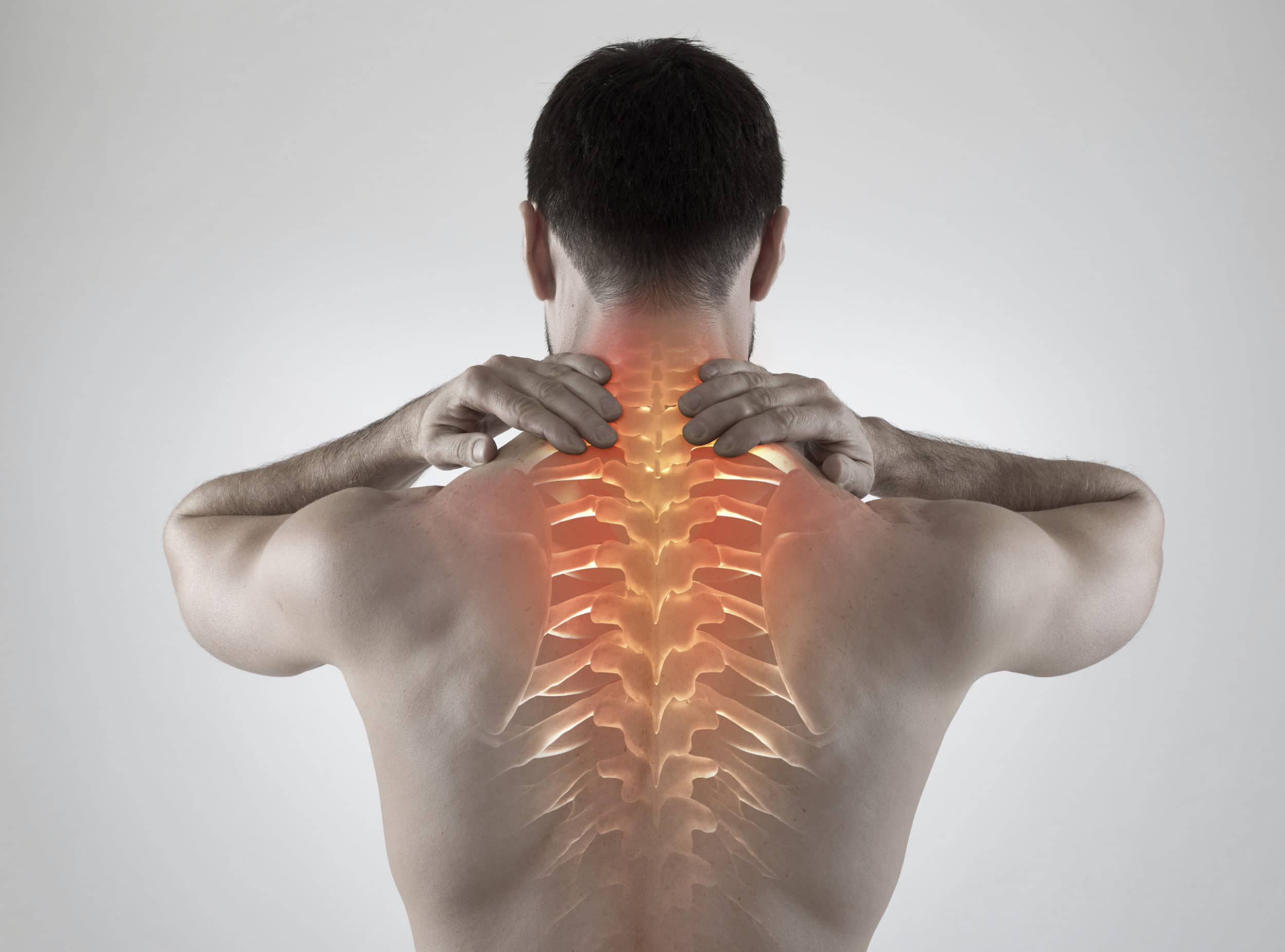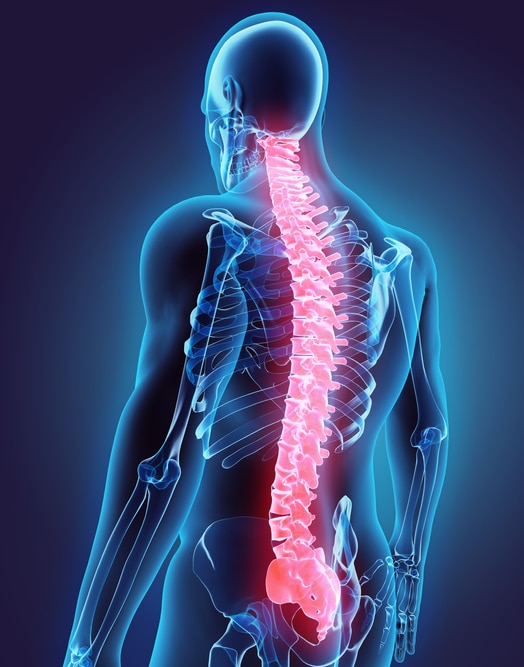What Is A Laminoplasty?
Injury and degenerated discs can diminish the space through which nerve roots exit the spinal cord. Laminoplasty is a surgical technique through which compression on affected nerves is reduced. As much as possible, laminoplasty is performed as a motion-preserving procedure, intended to leave the full range of motion in the affected spinal segment intact.

Each vertebra (bone) in the spinal column has several aspects. The lamina is the aspect of the vertebra that forms the roof of the spinal canal.
This part of the bony structure is positioned nearest to the skin of the back. Laminoplasty creates a “hinge” on the lamina, the back of the vertebra, and props this part of the bone slightly open so nerves have more room to exit.
What’s The Difference Between Laminoplasty And Laminectomy?
A laminoplasty is sometimes performed using microsurgery which is less invasive than traditional methods, but which requires both specialized training and specialized operating equipment. A laminoplasty is a less intrusive alternative to another operation for stenosis called a laminectomy.
Unlike a laminectomy, a laminoplasty does not remove the lamina and so manages to preserve spinal stability. This is an advantage because it helps the patient to maintain mobility and diminishes the need for future procedures to re-stabilize the spine.
Who Are The Ideal Candidates For A Laminoplasty Procedure?
Degeneration of the spinal discs and facet joints sometimes results in conditions called spinal stenosis and foraminal stenosis. Central spinal stenosis is a condition that narrows the center of the spinal canal where the spinal cord is housed. Foraminal stenosis narrows the foramen where nerve roots break off of the spinal cord to travel throughout the body. As the spinal canal narrows, nerves suffer compression that may cause pain, tingling, weakness, or numbness along the affected nerve path (to the arms, legs, or other areas). Depending on the degree of stenosis, bladder or bowel symptoms may occur.
Patients for whom conservative methods of treatment have not been successful may be helped by a posterior cervical laminoplasty procedure. Dr. Albert recommends surgery after conducting a thorough medical history, consultation, physical examination, and diagnostic imaging evaluation.
How Do I Prepare For Laminoplasty Surgery?
We ask that you refrain from taking any non-steroidal anti-inflammatory medicines 10 days before surgery such as:
- Aspirin, Advil, & Aleve
- Herbal supplements
- Vitamins E & K
- Fish oil
If your physician recommends that you do not stop Aspirin prior to surgery, please be sure to discuss this with our office. You should discontinue all exposure to products containing nicotine two weeks before and at least 6 weeks after your surgery.
The Laminoplasty Procedure
During laminoplasty surgery, Dr. Albert cuts the lamina, a small section of bone that covers the back of the spinal cord, completely on one side and partially on the other, enabling it to swing open like a door. Titanium spacers and plates hold open the lamina, increasing the amount of room around the spinal cord and decreasing compression on the nerves.
A laminoplasty can be performed on any of the three regions of the spine. The region performed on depends on where the patient is experiencing the most intense symptoms. The operation may be performed from the back or the front of the body, depending on the particulars of the patient’s condition. If a bone spur is present nearer to the anterior of the body, the surgeon may enter the body from the front.
The Posterior Cervical Laminoplasty Procedure
This spinal surgery is often performed under general anesthesia. The term “posterior” means that the affected spinal structures are accessed from the back of the neck. To achieve this, the patient is positioned face down on the operating table. Limited incisions are made to create access to the bony part of the vertebrae that are involved in nerve compression. Here, the facet joints are detached from the lamina on one side and partially detached on the other. This creates a hinge that can then be propped in an open position to remove pressure from the spinal cord. A metal plate or bone graft is placed as a prop that will integrate into bone tissue over time.
What To Expect After Laminoplasty Surgery
The first visit is 2-3 weeks after surgery however if you have any questions or concerns please call the office. If we think we should see you in the office we will schedule an earlier appointment.
Most patients do not have sutures that require removal. There are internal sutures that will dissolve with time. There will also be steri-strips (white pieces of tape) over the incision that will either fall off or we will remove them in the office.
Is Laminoplasty Surgery Painful?
Please keep in mind that pain is a very subjective experience and one’s reaction to surgery may vary based on the factors mentioned above. The most common concerns we hear from patients after laminoplasty surgery are related to incisional discomfort and discomfort around their scapula (or shoulder blade). Both of these tend to resolve prior to the first post-operative appointment at 2-3 weeks after surgery.
It is not uncommon for patients to experience “reminder” pain after surgery. This is when a patient begins to experience the same symptoms as they had before surgery. While this is common in recovery from spine surgery we understand that this can be very concerning to our patients. We encourage you to call the office with any concerns you may have after surgery.
Risks Of Posterior Cervical Laminoplasty
Spinal surgeries have improved significantly over the years. The risks of cervical laminoplasty are relatively low and include:
- Infection (this risk is less than 4%).
- Symptoms are unchanged or worsened after surgery.
Patient Testimonial
"Dr. Albert and his staff provide an extremely high level of care. He is the consummate professional in his area of expertise. Not only is he an excellent doctor, but he is also a very well-rounded human being. As a patient, I feel both confident in his surgical abilities and his personal caring approach to my surgical needs. I have recommended him to a number of my friends and coworkers."

"THANK YOU DOCTOR ALBERT Dear Dr. Albert & Staff,
There are not enough words to express how grateful I am to you and your wonderful staff. You answered all of my questions without making me feel foolish, and made me feel safe and comfortable with your warm smile, positive attitude, and thoroughness! Wishing you a happy & healthy new year!! Shanah Tovah"
Click here to view more patient testimonials.
Posterior Cervical Laminoplasty And Fusion Recovery
Surgery in the cervical spine may result in temporary tightness, soreness, or muscle spasms. These side effects may occur in the neck or shoulders and may linger for days or weeks. Medication and physical therapy are prescribed to manage pain and facilitate rapid healing as much as possible. In addition to mild to moderate discomfort, patients may also experience shooting pain, burning, tinging, or numbness. As nerves and tissue around the spine heal, these symptoms are expected to improve. Physical therapy is often prescribed 2-3 weeks after surgery and usually continues for several weeks. Patients often resume normal activities within two to three weeks after surgery, with the exception of strenuous physical exercise or work.
Laminoplasty FAQs
How Long Will I Be Wearing The Soft Collar?

Will I Set Off Metal Detectors?
Worried about getting through airport security after your procedure? Well, you don’t have to fret. Luckily, the titanium instrumentation does not set off metal detectors.
Can I Have An MRI After Laminoplasty Surgery?
Yes. The titanium instrumentation does not react to the magnet in the MRI machine. You should still notify the MRI facility of the presence of the instrumentation, in case of any other possible complications.
Schedule Your Posterior Cervical Laminoplasty Consultation In NYC!
If you are suffering from chronic neck or back pain, take advantage of a thorough consultation with an esteemed NYC spinal surgeon. Call 212-606-1004 to arrange your visit with Dr. Albert or fill out an online contact form and our office will be in touch with you.


